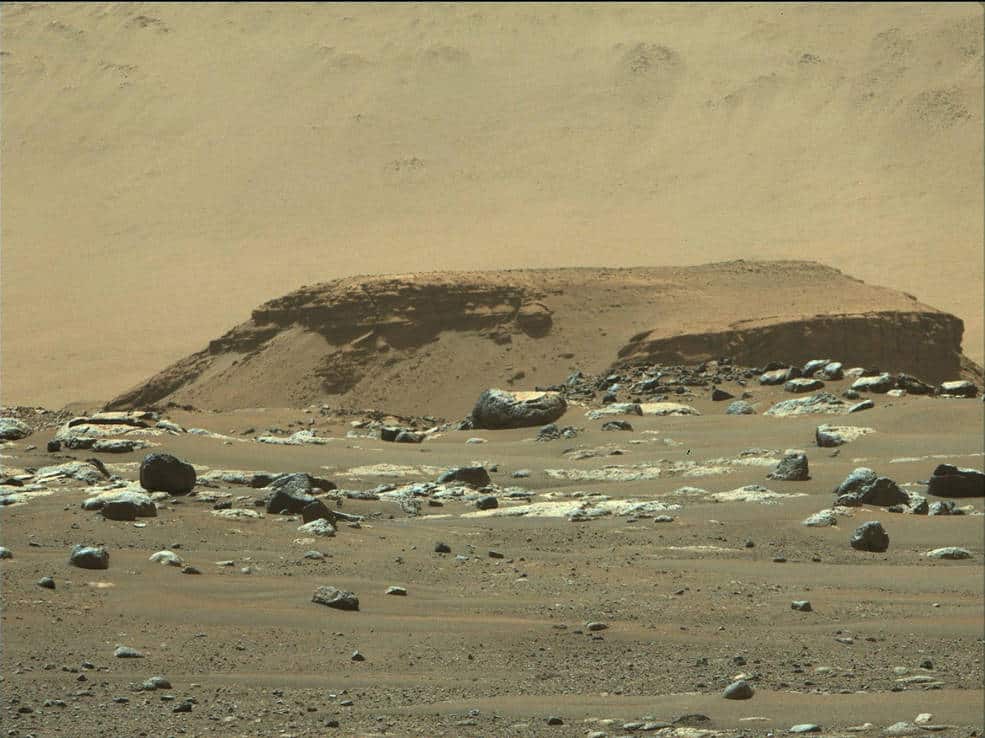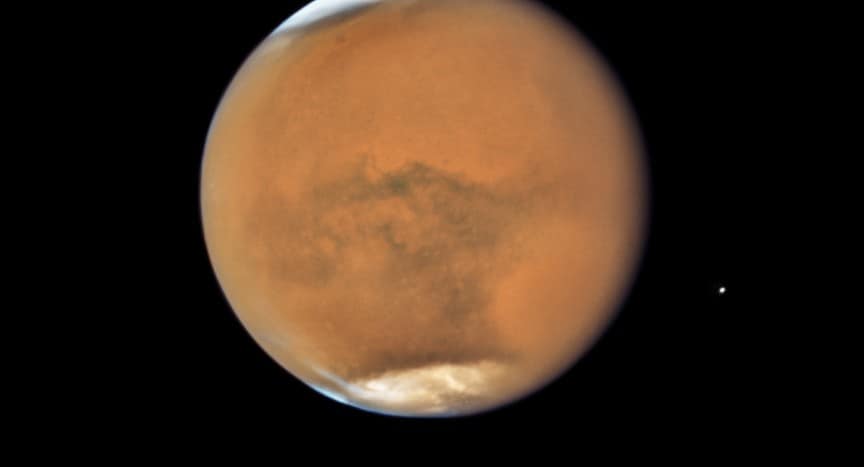Water may have existed much more recently on Mars based on observations of Martian sand dunes by China’s Zhurong rover.
Today Mars’ surface is extremely dry and its temperatures oscillate between extremes. But at some point in the very distant past, the red planet had flowing and standing water, until it lost its magnetic field and its atmosphere. This meant that any water on the planet was lost to space, except for some that is concentrated around the poles as glacial ice and permafrost.
(How Water Shaped Mars – New information from Perseverance Rover)

This image of “Kodiak” – one remnant of the fan-shaped deposit of sediments inside Mars’ Jezero Crater known as the delta – was taken by Perseverance’s Mastcam-Z instrument on Feb. 22, 2021.
Credits: NASA/JPL-Caltech/ASU/MSSS
Scientists have been trying to find out exactly when this transition from a water-filled planet to the dry and desolate place we see today took place and so, over the years, many spaceprobes, landers and rovers have been sent to Mars, the more recent ones being NASA’s Perseverance Rover and the Chinese Space Agency’s Tianwen 1 probe and Zhurong Rover.
(NASA’s Perseverance Rover Sends Back Video of Landing on Mars)
Tianwen-1 comprising of an orbiter and a 240 kg Zhurong rover, was launched on July 23, 2020 and entered Martian orbit on February 10, 2021. Then on May 14, 2021, the lander/rover portion of the mission successfully touched down on Mars, making China the third nation after the Soviet Union and USA to make a soft landing on and establish communication from the Martian surface. It landed on the Utopia Planitia impact basin (a gigantic plain and the largest impact basin in the Solar System), north of Mars’ equator.The orbiter has seven remote-sensing instruments to study the planet’s atmosphere, as well as its surface, and its camera will take images from orbit.

A wireless camera took this ‘group photo’ of China’s Tianwen-1 lander and rover on Mars’ surface. Credit: Chinese Space Agency
The Zhurong rover drove on to the Martian surface on May 22, 2021. It has a camera on board to take photographs, and also carries five additional instruments to assess the mineralogy of local rocks and look for water-ice. A ground-penetrating radar can sense geological layers at tens meters’ depth. It has now spent almost a year analysing the surface.
And all of this effort has borne fruit. According to the Tianwen-1 mission, water may have existed on the Martian surface later than previously thought.
Zhurong rover was able to observe salt-rich Barchan dunes in the Utopia Planitia region, which seemed to show cracks and crusts, probably mixed with melting morning frost or snow. All of this indicates the possible presence of water as recently as a few hundred thousand years ago: sometime after 1.4 million to 400,000 years ago or even younger, according to the scientists.

Though Mars is the Red Planet, false-color images can help us learn about its weather and geology. This image shows a variety of wind-related features on the Red Planet near the center of Gamboa Crater. Larger sand dunes form sinuous crests and individual domes. Credit: NASA/JPL-Caltech/University of Arizona

Barchan dunes in the North Pole of Mars Credit: NASA JPL

Exploration route of Zhurong rover and cracks on bright sand dunes.
(A) Map of the exploration route of Zhurong from May to September 2021. The HiRIC photo (0.7-m resolution) was taken by the Tianwen-1 orbiter. Dunes 1 to 4, marked by white rectangles, were measured in situ on Sols 45, 64, 92, and 99, respectively. (B) Panorama mosaics acquired by NaTeCam of longitudinal dunes on barchan Dune 2, with white rectangles indicating positions of the cracks. (C and D) Cracks developed on the southwestern slope of longitudinal dune on the western wing of Dune 2, with a white arrow pointing to one of the cracks. (E) Panorama mosaics acquired by NaTeCam of barchan Dune 3, with white rectangles indicating positions of the cracks. (F) Cracks on the northern slope of Dune 3. Credit: CNSA/GRAS.
The team was able to rule out dry ice and wind as the possible candidates for these features:
“Instead, involvement of saline water from thawed frost/snow is the most likely cause. This discovery sheds light on more humid conditions of the modern Martian climate and provides critical clues to future exploration missions searching for signs of extant life, particularly at low latitudes with comparatively warmer, more amenable surface temperatures.”, they write in the study published in Science Advances on April 28, 2023.
As they explain in the study: “First, water vapor condensed as frost/snow on the dune surfaces when the temperature dropped below the frost point. Then, the frost/snow on salts in between the sand grains would thaw to eventually form saline water after the eutectic temperature was attained, and the saline water might accelerate the formation of hydrated silica and ferric oxides. Subsequently, the salinewater would vaporize, and salts precipitate to cementsand grains as temperature reached above boiling point or low–water vapor content air flowed, thus agglomerating particles and forming crust. Then, continued drying or freezing would develop cracks within the crust. Last, repeated frost precipitation-thawing cycles could leave other traces related to water activity in the interdune depression. Therefore, these crusts, cracks, and aggregates observed on the dune surfaces in Zhurong landing area provided the plausible evidence that saline water existed contemporarily at low latitudes on Mars.”
Computer simulations run by the team were additionally combined with observations made by other robotic missions. These findings indicate that there could be new and potentially fertile areas in Mar’s warmer regions, where conditions could also be suitable for the existance of life.
As the study authors state:
“This discovery sheds light on more humid conditions of the modern Martian climate and provides critical clues to future exploration missions searching for signs of extant life, particularly at low latitudes with comparatively warmer, more amenable surface temperatures.”
Even if small, the possibility of liquid water patches on the surface of our neighbouring planet could indicate the existence of life. How cool would that be for future missions and research?
“Our findings provide useful clues for designing future exploration strategies for Mars rovers. Special attention should be paid to
small depressions and encrusted soil surfaces, with the objective to look for more evidence of saline water to better understand contemporary climate changes at low latitudes on Mars. As saline water once existed at various latitudes on the surface of Mars, priority should be given to salt-tolerant microbes in future missions searching for extant life on Mars.”
Sadly, the Zhurong rover went into hibernation over the Martian winter nearly a year ago (after travelling 1,921 meters (1.194 miles) across the surface) and mission leaders have acknowledged that it has yet to wake up. But what great hope for future research it has left us with!
TL;DR? Here’s a quick video
Full study on Science Advances







